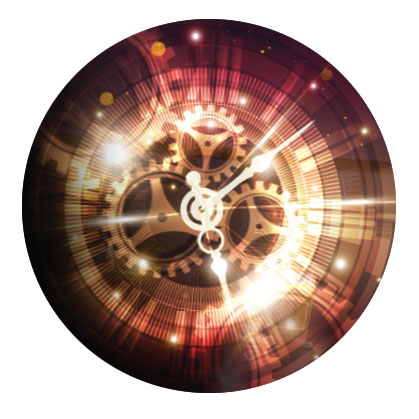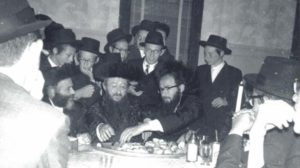All’s Good at Shalosh Seudos

At Shalosh Seudos, our focus is on yichud with Hashem

W
hen it comes to Shabbos meals, Shalosh Seudos is is an outlier.
I remember the Leil Shabbos and Shabbos day meals of our school shabbatons and camp being lively and spirited affairs, zemiros harmonized at impossible decibels, and a general atmosphere of almost chaotic exuberance.
Shalosh Seudos on the other hand, was slow and contemplative, soulful tunes melding with stirring divrei chizuk. For years, I associated Shalosh Seudos with an intensely spiritual, almost ethereal time.
Fast-forward to adulthood and Shalosh Seudos is abruptly downgraded to second-class status. While the first two seudos are invested, multicourse events, Shalosh Seudos seems almost an afterthought; challah, a hastily cut salad, some tuna and gefilte fish, leftover brownies perhaps. In some communities, the final Shabbos seudah is not even a formal meal; the men partake in shul, and the women scour the fridge for a hasty repast.
Clearly Shalosh Seudos is a Shabbos meal that has the potential to uplift and inspire, perhaps even more so than the ones preceding it. Yet we often find that it doesn’t feature as prominently in our Shabbos experience as its counterparts.
The halachos of Shalosh Seudos echo this ambivalence. The Tur (Orach Chaim 291) exhorts us to eat all three Shabbos meals: “Everyone who partakes in three meals [on Shabbos] is protected from three afflictions: The birth pangs of Mashiach, the judgment of Gehinnom and the [war of] Gog u’Magog.” The Bach (ibid) teaches that this seudah corresponds to the Shabbosim after Mashiach comes. Additionally, Iyun Yaakov (Shabbos 317) refers to this meal as the exclusive seudah of the neshamah yeseirah, the extra neshamah we’re granted each Shabbos.
From these opinions alone, we understand that Shalosh Seudos is a sacred time with vast spiritual implications. And yet, when it comes to the halachic fulfillment of this seudah, we find a much more fluid approach than to the other two meals of the day.
The Shulchan Aruch rules that in contrast to Leil Shabbos and Shabbos day, we do not make Kiddush before Shalosh Seudos. And although it is preferable to wash and have lechem mishneh, we may fulfill our obligation with food from one of the five grain species, fish, meat, or even fruit!
The dichotomy here is obvious: If the third Shabbos meal is indeed a spiritually opportune time, how do we justify treating it less honorably than the other two Shabbos meals?
It’s All One
The exceptionality of Shalosh Seudos actually begins earlier, with Minchah — the tefillah of middas hadin, judgment. Introduced by Yitzchak Avinu, whose salient middos were gevurah and din, Minchah is a time of critical evaluation, all week long, when we’re called to account for the gifts Hashem bestows on us. But when Shabbos arrives, Minchah assumes a new identity; it morphs into a time of immense desire and goodwill from Hashem.
Rava d’ravin is the Zohar’s term for this auspicious time on Shabbos, which extends from Minchah until the end of Shalosh Seudos. Aramaic for ratzon haretzonos, desire of desires, during this brief window Hashem reveals His unmitigated desire for Klal Yisrael. That being the case, we might expect the Minchah of rava d’ravin to resonate with themes of longing and yearning. Yet instead, the nucleus of Shabbos Minchah proclaims Atah echad v’Shimcha echad: You are One and Your Name is One.
Oneness? It seems rather understated to distinguish this elevated time with a concept as elementary as Hashem’s oneness. And how does the fact that Hashem is One correspond to the sublime message of rava d’ravin, yearning and desire?
Rav Shimshon Dovid Pincus (Shabbos Malkesa) reframes our understanding of Hashem Echad: “The creation and all that it encompasses exists because it is His wish that each aspect [of creation] occur precisely as it is. As such, we find that the world, a conglomerate of diverse, wide-ranging creations… is [in actuality an expression] of His diverse and wide-ranging desires: happiness alongside sadness, light in conjunction with darkness, holiness beside impurity, every component presents in reality precisely as He wills it to be. Intrinsically, the world in its entirety is [a fusion] of His manifold, distinct desires.”
Nothing would exist if not for the will of Hashem; the world is a collection of Hashem’s various wills. Some of them may seem contradictory, such as happiness and sadness or light and darkness. However, one underlying will unifies all the apparent diversity: Kol d’avid Rachmana, l’tav avid, everything Hashem does, He does for the good.
When we encounter the inevitable snags and hitches in life, they rankle. Whether they’re small scale, like a flat tire or a backed-up sink, or more significant, like illness, family discord, or impossible debts, we wonder: “Why would Hashem want me to suffer? Doesn’t He want to see me happy and settled?” This is when reflecting on kol d’avid Rachmana, l’tav avid is crucial.
The same Hashem who sent you the perfect chassan for your child is the One Who is sending the debt. The same Creator Who found you the impossible parking spot is the One who sent you the flat tire. And the same One Who healed your father sent you the difficulty with your in-laws.
Some things may seem contradictory, but there is one underlying will that unifies all the apparent diversity: Kol d’avid Rachmana, l’tav avid.
In the shadowy pretense of this world, we often do not see the l’tav of Hashem’s avid. Only after Mashiach comes, when our narrow vantage point is stretched to impossible vistas, will we see that the excruciating was — not. This is the true meaning of Hashem Echad; everything in this world, from the agonizing to the euphoric, is in truth one: unadulterated good.
From Shabbos Minchah through Shalosh Seudos, Hashem’s true desire, the rava d’ravin is revealed. Shalosh Seudos corresponds to the Shabbosim after Mashiach has come, when the blinding clarity of Hashem’s goodness will wipe clear all the questions we wrestle with in this world.
And that clarifying light of Shabbos shines brighter at Shalosh Seudos, illuminating the goodness of Hashem behind the pain. This is also the reason it’s the seudah of the neshamah, the fundamental essence of a person; l’tav avid is the essence of every facet of Hashem’s world.
The inspiration we experience at this third seudah now makes perfect sense. Hashem has revealed His true desire, and our natural response is a feeling of closeness and spiritual uplift.
Just the Relationship
The Avudraham likens Shabbos to the marriage between Hashem and Bnei Yisrael. Leil Shabbos corresponds to the kiddushin, Shabbos day parallels the nisuin, and Minchah is compared to the yichud room, where the most connected, intimate moments occur and the couple’s strongest wishes are shared. Despite the abundance of haute cuisine, rare are the chassan and kallah who divert their attention from each other to something as mundane as food. Because in the yichud room, when it’s all about relationship, everything else is a diversion.
So too with Shalosh Seudos when our focus is on our yichud, oneness, with Hashem. The halachic parameters of the actual meal are more relaxed, freeing us up to concentrate on our relationship with Him. The zemiros of Shalosh Seudos maintain this focus; “Yedid Nefesh,” the standard Shalosh Seudos zemer, is a moving tribute to the love between Hashem and Klal Yisrael.
Shalosh Seudos is the meal of Echad. We are one with Hashem in the yichud room, basking in the rava d’ravin, Hashem’s desire for us, imbibing the truth of His oneness. And with the clarity gleaned from this final meal, we take leave of Shabbos and approach the new week, confident in the knowledge that regardless of what we encounter, everything is l’tav avid, for our ultimate good.
Originally featured in Family First, Issue 648. Mrs. Elana Moskowitz has been teaching in seminaries for nearly 20 years.
Oops! We could not locate your form.







